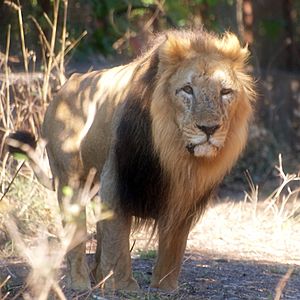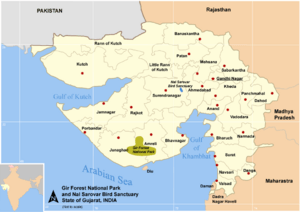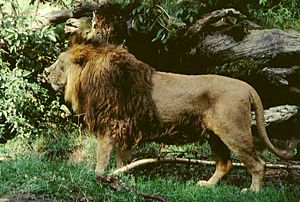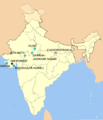Asian lion facts for kids
Quick facts for kids Asiatic lion |
|
|---|---|
 |
|
| Male Asiatic lion in Gir National Park | |
 |
|
| Lioness in Gir Forest | |
| Conservation status | |
| Scientific classification |
|
| Kingdom: | Animalia |
| Phylum: | Chordata |
| Class: | Mammalia |
| Order: | Carnivora |
| Suborder: | Feliformia |
| Family: | Felidae |
| Subfamily: | Pantherinae |
| Genus: | Panthera |
| Species: | |
| Subspecies: |
P. l. leo
|
| Trinomial name | |
| Panthera leo leo (Linnaeus, 1758)
|
|
 |
|
| Current range of the Asiatic lion | |
| Synonyms | |
|
|
The Asiatic Lion (Panthera leo persica) is a special type of lion. It is also called the Indian lion. Today, you can only find these lions in India. Long ago, they lived in a much larger area, from the Mediterranean Sea all the way to India. This huge area included most of Southwest Asia, which is why they are sometimes called Persian lions. Asiatic lions have a coat that is a warm cinnamon color. This lion was once the official animal of the old Junagadh State.
Contents
What Makes Asiatic Lions Special?
The fur of the Asiatic lion can be many shades. It ranges from a reddish-brown with black spots to a sandy or grayish-yellow. Sometimes, it even looks silvery in certain light.
Male Asiatic lions have a moderate mane. This mane grows mostly on top of their head, so their ears are always easy to see. The hair on their cheeks and throat is quite short, only about 10 cm (3.9 in) long.
One unique feature of the Asiatic lion is a fold of skin. This fold runs along its belly. It's a clear way to tell them apart from African lions.
Size and Weight
Male Asiatic lions stand about 107–120 centimetres (3.51–3.94 feet) tall at the shoulder. Females are a bit smaller, standing 80–107 centimetres (2.62–3.51 feet) tall.
Two lions measured in the Gir Forest were about 1.98 m (78 in) long from head to body. Their tails were about 0.79–0.89 m (31–35 in) long. This made their total length around 2.82–2.87 m (111–113 in).
Adult male Asiatic lions usually weigh between 160 to 190 kg (350 to 420 lb). Females are lighter, weighing about 110 to 120 kg (240 to 260 lb). These lions are similar in size to the Central African lion. However, they are smaller than the very large African lions.
Lion Manes
The color and size of a male lion's mane can change. It depends on where the lion lives, its age, and its family group. Generally, Asiatic lions have smaller manes compared to African lions.
Lions that lived in ancient Greece and Asia Minor also had smaller manes. Their manes did not reach below their bellies or sides. Lions with similar smaller manes were found in places like Syria, the Arabian Peninsula, and Egypt. However, lions from North Africa, like the Barbary lion, had hair under their bellies.
How Asiatic Lions Live
Male Asiatic lions often live alone. Sometimes, they form small groups of up to three males. These groups are called loose prides. Pairs of males will rest, hunt, and eat together. They also mark their territory in the same spots.
Female lions form stronger prides. These groups can have up to 12 females, along with their cubs. They share large animals they hunt among themselves. However, they rarely share with males. Male and female lions usually only spend a few days together when they are mating. They do not often travel or eat together.
Home Ranges
Studies using radio tracking show how much space lions need. Male lions have large home ranges, from 144 to 230 km2 (56 to 89 sq mi). Female lions have smaller home ranges, between 67 and 85 km2 (26 and 33 sq mi).
During hot, dry times, lions prefer areas with thick plants and shade near rivers. This is also where their prey animals gather. Groups of male lions protect their home ranges. These ranges often contain one or more female prides. Male groups can hold a territory longer than a single lion. In groups of three or four males, one male is usually the leader.
What Asiatic Lions Eat
Lions generally prefer to hunt large animals. They like prey that weighs between 190 to 550 kg (420 to 1,210 lb). Historically, farm animals like cattle were a big part of the Gir lions' diet.
Inside the Gir National Park, lions mostly hunt chital (a type of deer), cattle, buffalo, sambar (another deer), and nilgai (a large antelope). They also sometimes hunt wild boar. Chital are the most common prey, even though they only weigh about 50 kg (110 lb). Sambar deer are often hunted when they come down from the hills in summer.
Outside the park, where wild prey is scarce, lions hunt buffalo and cattle. They rarely hunt camels. Most of their prey is caught close to water sources. Lions charge their prey from nearby and drag their kills into thick bushes to eat.
Over the years, the number of wild animals in the park has grown. This means lions now hunt fewer farm animals inside the park. Most farm animal attacks now happen in villages outside the protected area.
When male lions hunt together, the dominant male eats more. He consumes about 47% more of the kill than his partners. If the group is large but the kill is small, the males might fight more over the food.
Reproduction and Life Cycle
Asiatic lions mostly mate between September and January. Mating can last for three to six days. During this time, they usually do not hunt. They only drink water.
A female lion is pregnant for about 110 days. She then gives birth to one to four cubs. The dominant male in a group mates more often than the other males. Cubs become independent when they are about two years old. Young males leave their family pride by the age of three. They wander alone until they can find and claim their own territory.
Other Animals in the Lion's Home
The Gir forest is also home to other meat-eating animals. These include the Indian leopard, striped hyena, jungle cat, Asiatic wildcat, and rusty-spotted cat. The golden jackal eats leftover meat from large animals. It also hunts young chital and Indian hares.
In the past, Asiatic lions shared their home with other big cats like the Asiatic cheetah and tiger. They also lived alongside the Indian wolf and different types of bears.
Lion Versus Tiger
Until the late 1800s, Asiatic lions lived in the same areas as tigers. This was true for parts of Western and Central Asia, and India. For example, lions and the now-extinct Caspian tiger lived in northern Iraq.
In India, the Asiatic lion lives in the Kathiawar Peninsula. The Bengal tiger lives in a different area, near the borders of Gujarat, Maharashtra, and Madhya Pradesh.
Protecting Asiatic Lions
The Asiatic lion (Panthera leo persica) is a protected animal. It is listed on CITES Appendix I, which means it is in danger and trading it is strictly controlled. In India, it is fully protected by law.
Images for kids
-
A painting of Mughal Emperor Shah Jahan hunting lions in 1630.
See also
 In Spanish: León asiático para niños
In Spanish: León asiático para niños











